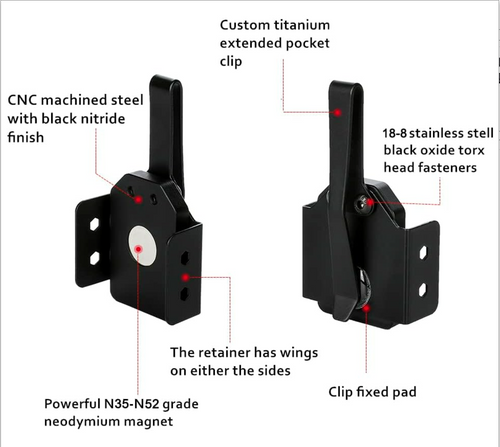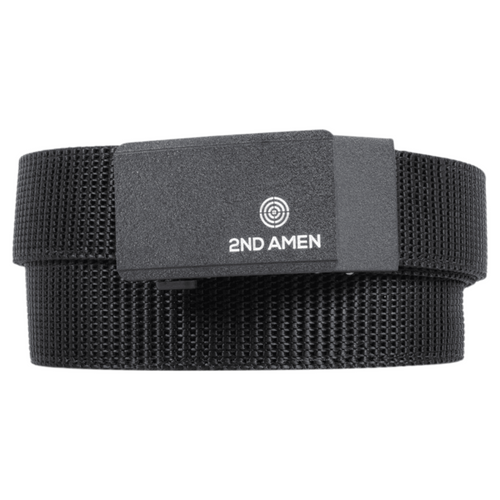Choosing between leather and Kydex holsters for concealed carry? Here's what you need to know:
- Leather Holsters: Flexible, comfortable, and molds to your firearm over time. They offer a quiet draw and excellent skin comfort but need regular maintenance and may lose shape over time.
- Kydex Holsters: Rigid, durable, and ready to use immediately. They provide consistent retention, are weatherproof, and allow for faster draws, but can feel less comfortable and may cause wear on your firearm's finish.
Quick Comparison
| Feature | Leather | Kydex |
|---|---|---|
| Comfort | Flexible, gentle on skin | Rigid, may cause pressure |
| Break-in Time | Requires break-in | Ready to use immediately |
| Retention | Relies on friction, changes over time | Precision-molded, consistent |
| Maintenance | Requires regular care | Minimal upkeep |
| Concealment | Conforms to body over time | Slim and rigid |
| Durability | Can wear out over time | Long-lasting and sturdy |
Key Takeaway: Leather is ideal for comfort and extended wear, while Kydex is better for durability, retention, and active use. Pick the one that fits your lifestyle, daily carry habits, and personal preferences.
Leather Holsters: Core Details
How Leather Holsters Work
Leather holsters naturally mold to your firearm over time, creating a secure and personalized fit. This process is particularly useful for concealed carry.
Key traits of leather include:
- Flexibility: Adapts to the shape of your firearm.
- Moisture resistance: Protects against corrosion.
- Durability: Retains structure even with regular use.
These qualities make leather holsters a solid choice for concealed carry.
Why Leather Works Well for CCW
Leather holsters offer several advantages for concealed carry, thanks to their natural properties. Here's a quick overview:
| Feature | Benefit for CCW |
|---|---|
| Silent Draw | Eliminates noise when drawing your firearm. |
| Skin Comfort | Gentle on the skin, reducing irritation. |
| Moisture Protection | Shields your firearm from rust and corrosion. |
| Custom Fit | Conforms to your firearm's contours for better concealment. |
"Leather holsters are also an excellent choice for concealed carry... This snug fit ensures that your firearm does not print and stays in place, making it easier to conceal."
Common Challenges with Leather
Leather holsters require regular care to maintain their performance. A key part of this is the break-in process, during which the holster adjusts to your firearm for an ideal fit.
"A new leather holster is an exciting thing to purchase and wear, but they do require some break-in. After all, you want your firearm to fit as perfectly as possible."
To keep your leather holster in top shape, follow these care tips:
- Clean regularly: Use warm water and glycerin soap with a soft brush.
- Wipe down after use: Dry it with a clean cloth to remove moisture.
- Use spray silicone: Apply to the interior to reduce friction and add moisture protection.
- Store properly: Keep it in a cool, dry place, ideally in a breathable bag.
Avoid these common mistakes:
- Skip standard leather conditioners: These can overly soften the holster.
- Separate brass ammo: Storing it with leather can cause verdigris buildup.
- Avoid extreme drying methods: Don’t let wet leather dry in high heat or direct sunlight.
With proper care and attention, a leather holster not only lasts for years but also develops a unique patina that adds character over time.
Kydex Holsters: Core Details
What Makes Up a Kydex Holster
Kydex is a thermoplastic material made from acrylic and polyvinyl chloride. It combines the stiffness of acrylic with the durability and chemical resistance of polyvinyl chloride, making it a popular choice for concealed carry (CCW). Key features include:
- Hardness: Rockwell R rating of 90
- Thickness: Standard 0.08 inch, ensuring both durability and comfort
- Resistance: Waterproof and resistant to chemicals
Kydex holsters are custom-molded to fit specific firearm models through a thermoforming process. This ensures a snug fit that retains its shape even after heavy use.
What Makes Kydex Good for CCW
Kydex holsters offer several benefits for concealed carry, thanks to their precision molding and reliable retention:
| Feature | CCW Benefit |
|---|---|
| Precise Fit | Produces an audible "click" when holstered, ensuring a secure hold |
| Quick Draw | Low friction allows for faster drawing of the firearm |
| Weatherproof | Waterproof and dries quickly, even in challenging conditions |
| Slim Profile | Thin and rigid, making it easier to conceal under clothing |
These qualities make Kydex a practical option for CCW, though it’s important to consider some of its limitations.
Common Issues with Kydex
Despite its advantages, Kydex holsters have a few drawbacks:
- Firearm Wear: The rigid material can cause wear on the firearm's finish over time.
- Comfort: Hard edges and lack of flexibility may lead to discomfort or pressure points.
- Maintenance: Retention screws can loosen and may require regular tightening.
- Limited Compatibility: Each holster is designed for one specific firearm model.
To keep your Kydex holster functioning properly, check retention screws regularly and inspect for signs of wear, such as cracks or excessive bending. Being aware of these factors can help you decide whether Kydex or leather holsters are better suited for your concealed carry needs.
Leather Holsters VS Kydex Holsters
sbb-itb-7fb5bb8
Direct Comparison: Leather vs Kydex
When it comes to concealed carry, finding the right balance between comfort, security, and durability is key.
Comfort and Break-in Time
Leather holsters are naturally flexible, making them comfortable from the start. However, they do require a break-in period that can last days or even weeks. On the other hand, Kydex holsters are ready to use immediately. Their rigid structure provides consistency, though some users may find them less comfortable at first.
Weapon Security and Hold
Retention is critical for concealed carry, especially in self-defense scenarios. Here's how leather and Kydex compare in terms of security:
| Feature | Leather | Kydex |
|---|---|---|
| Retention | Relies on friction | Precision-molded with active retention |
| New Hold | Secure when new | Consistent hold with an audible "click" |
| Long-term | May loosen over time | Maintains its original retention |
Long-term Care and Wear
Kydex holsters are low-maintenance and retain their shape over time. They resist water, sweat, and other environmental factors. Leather holsters, however, require regular care. This includes cleaning with specialized products, applying moisture protection, and performing routine checks to maintain their performance.
These differences in upkeep can also influence how each holster performs during concealment and quick-draw scenarios.
Hide-ability and Draw Speed
Kydex holsters are precision-molded, giving them a slim profile that makes concealment easier. Their smooth, low-friction surface also allows for faster draws. Leather holsters, while initially bulkier, gradually conform to the body, improving their concealability over time.
Price and Value
When looking at cost and durability, Kydex often stands out. For example, the Breakout 2.0 IWB holster, priced at $69.99, highlights the long-term value of Kydex. It offers comparable upfront costs but outlasts leather holsters due to its durability and minimal maintenance needs. Leather holsters, by contrast, often require additional spending on care and may need replacement sooner.
Making Your Holster Choice
Think about how your lifestyle and daily habits align with your holster needs.
Key Decision Points
When deciding between leather and Kydex holsters, keep these factors in mind:
- Daily Carry Duration: Leather is more comfortable for extended wear. If you're carrying for shorter periods, Kydex's rigidity may suffice.
- Activity Level: Kydex is better for high-activity situations due to its moisture resistance and reliable retention. Leather works well for less active use, thanks to its flexibility.
- Climate: In hot or humid conditions, Kydex's ability to resist moisture makes it a solid choice. Leather, on the other hand, needs more care in such climates.
Best Uses for Each Type
Specific scenarios call for specific holster features. Here's a quick comparison:
| Scenario | Recommended Material | Key Benefits |
|---|---|---|
| Daily Office Carry | Leather | Comfortable and flexible, especially when seated |
| Active Lifestyle | Kydex | Moisture-resistant with consistent retention |
| Training Classes | Kydex | Durable and allows easy reholstering |
| Extended Concealment | Leather | Conforms to the body, reducing visible printing |
While choosing the right material is important, don't overlook the quality of the holster itself.
Build Quality Matters
The performance and durability of your holster heavily depend on its construction. For example, the Breakout 2.0 IWB holster showcases excellent craftsmanship with:
- A custom-molded fit tailored to specific firearm models
- Reinforced stress points to boost durability
- Smoothly finished edges that protect your firearm from wear
- High-quality hardware that maintains secure tension settings
When assessing build quality, focus on these details:
- Material Thickness: Good Kydex holsters typically use 0.08" thickness for a balance of durability and concealment.
- Retention Design: Reliable retention systems are key. Quality Kydex holsters produce an audible "click" when the firearm is seated properly. Premium leather holsters often include reinforced openings to retain their shape.
- Edge Treatment: Well-finished edges prevent wear on both the holster and the firearm, a feature that sets premium options apart from budget models.
The quality of your holster is just as important as the material, ensuring it performs well and lasts through daily use.
Final Thoughts: Making Your Choice
Deciding between leather and Kydex for your CCW holster comes down to your specific needs and personal preferences.
"As with anything else in life, it isn't that one is better than another; it's more that you have to pick the set of problems that you prefer to live with." - Sam Hoober
Think about how your lifestyle, environment, and willingness to handle upkeep align with each material's strengths. Here are a few key points to consider:
- Lifestyle Fit: If you spend hours sitting at a desk or in a vehicle, leather's flexibility might feel more comfortable. On the other hand, if you're more active or frequently deal with moisture, Kydex's sturdiness and reliable retention could be a better match.
- Climate Considerations: Where you live matters. Humid conditions can be tough on leather, requiring extra care, while Kydex maintains its shape and performance effortlessly. However, leather tends to offer better comfort across varying temperatures.
- Maintenance and Durability: Leather needs regular attention to stay in good shape, while Kydex is practically maintenance-free. Decide how much effort you're willing to put into keeping your holster in top condition.
Above all, prioritize quality over material. A well-made holster, regardless of whether it's leather or Kydex, will serve you far better than a poorly crafted one. Look for something that fits your carry style, offers security, and ensures quick access when needed.
The best holster is the one you'll wear consistently, train with, and trust. Choose the one that fits seamlessly into your daily life and supports responsible concealed carry.




